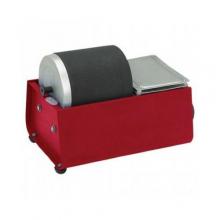A ball mill, a type of crusher, is a cylindrical device used to grind chemicals or mix compositions. Ball mills rotate around a horizontal axis, partially filled with the material to be ground plus the grinding medium, ideally non sparking milling media like lead balls. An internal cascading effect reduces the material to a fine powder. Industrial ball mills can operate continuously, fed at one end and discharged at the other. Large to medium ball mills are mechanically rotated on their axis, but small ones normally consist of a cylindrical capped container that sits on two drive shafts (pulleys and belts are used to transmit rotary motion).
Ball mills used to produce explosive mixtures such as black powder should never be operated inside buildings inhabited by people. They require a separate facility away from buildings and flammable substances and protected from the public with a suitable defence wall or barricade made of something with some mass to absorb possible fragments from the exploding ball mill. A proper warning sign telling passers by of the explosive conditions behind the wall {on all four sides} is recommended. Venting to sky is needed to allow explosive gases to escape. This vent should be screened with heavy wire mesh. Preferably, a padlocked door for user access only.
Rock tumblers work in an identical fashion to ball mills, however they are used for polishing mineral specimens. Using pyrotechnical milling media they can easily be made to mill chemicals.
Ball mill method
Ball milling is more dangerous method of mixing pyrotechnic compositions as it produces large amounts of shock and friction. Lead balls or any non sparking grinding media are used inside the ball mill to 'crush' the ingredients, non sparking grinding media are essential for safety when preparing pyrotechnic chemicals such as black powder. As with the screen method it should only be practiced with compositions that are insensitive to shock and friction.
Utilizing this method of mixing can be just as safe as others if you are mixing compositions that contain an oxidizer, but no fuel and visa versa. For example, you can safely mix fuels like charcoal and sulfur together or oxidizers like potassium nitrate on their own. If you choose to mix compositions this way then after milling, just screen them together (via the screen method) until the mixture is completely homogeneous. This is also a safe method when mixing compositions that have no sensitivity to shock or friction.
A ball mill will deliver a superior homogeneous mixture with the ingredients being ground together by the milling media. It method of mixing is mainly used in making powders such as meal, pulverone, black powder etc. To reduce the risk even of accidental ignition even further, the mixture can be moistened with water or an appropriate solvent.
Operating values
As a rule of thumb in dry grinding, milling jar should be filled half full of it's volume with milling media and a quarter full of it's volume with material to be milled (optimum loading is not possible with small rock tumblers, since they will overload). The rotational speed of the milling jar should be ~65% of the critical speed of the jar. The critical speed is 'the speed when a ball mill becomes a centrifuge' and may be calculated for a specific jar and ball diameters as follows: CS[rpm] = 2676 / SQR( JarID[mm]-BallOD[mm] ). The material to be milled should be reduced to appr. 8 mesh prior ball milling. Proper milling time may be tested by taking and sieving samples during the test milling. During sampling it should be checked, that the mill does not 'run dry'; the media should be just covered with the material. Running mill dry and/or of excessive period of time, will result in wear of the milling media and contamination of the material. Slight over filling will reduce the risk of running dry - especially charcoal will loose it's occupied volume during milling.
| Jar Dia [mm] x Length [mm] | Jar volume [litre] | Material volume [litre] | Media volume (*1) [litre] | Ball diameter [mm] | Ball app.qty (*2) [pcs] | Critical speed [r/min] | Optimum speed [r/min] |
| 100mm x 100mm | 0.8 | 0.2 | 0.4 | 12,5 | 125 | 143 | 93 |
| 150mm x 150mm | 2.6 | 0.7 | 1.3 | 12,5 | 450 | 114 | 74 |
| 200mm x 200mm | 6.3 | 1.6 | 3.1 | 15 | 700 | 98 | 64 |
| 250mm x 250mm | 12.3 | 3.1 | 6.1 | 20 | 800 | 88 | 57 |
| 300mm x 300mm | 21.2 | 5.3 | 10.6 | 25 | 900 | 81 |
52 |
(*1) the volume occupied by the media in the jar, including crevices. (*2) based on approx.calculation, not yet confirmed.

